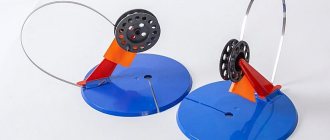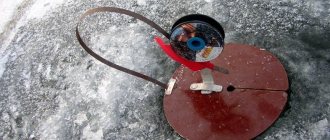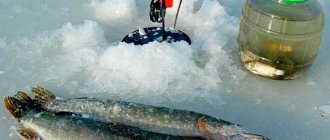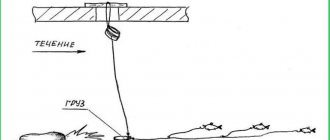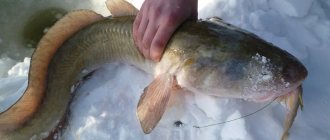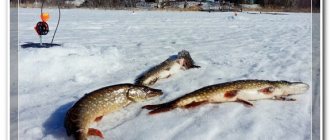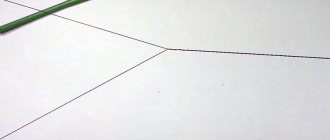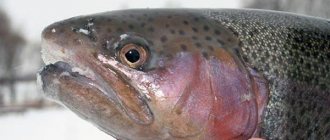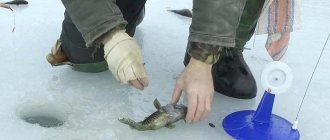Fishing with girders is one of the oldest methods of hunting for predatory fish, which was used by primitive fishermen. The tackle has reached our time as a more modernized fishing device, which, keeping pace with the advent of progressive modern materials, is still undergoing improvements and modifications today.
Peculiarities of catching pike with summer girders and their types
Depending on the season, girders are divided into winter and summer. In other words, gear for closed or open water, which determines their design. According to the installation method, there are floating ones (circles), on a stationary pole (postavukhs), and slingshots for fishing from the shore.
Summer to winter zherlitsa
Winter gear for catching predators can be easily converted into a summer version using sheet insulation and thick rope. In open waters, with the help of an installed signal flag, the bite is quickly detected. The effectiveness of winter girders, which are competently converted, subject to the calculations of the technical characteristics of the gear, is not inferior to their summer counterparts.
The depth of the bait should not be less than 1 meter and no more than 2 meters, since it is in these layers of the reservoir that the temperature is optimal for live bait.
Mugs (floating mugs)
The essence of this fishing method is the natural movements of the bait, which should interest and provoke the predator to attack. Correct calculation of the technical characteristics of the fishing rod will ensure a guaranteed catch, and the slightest errors and errors in the manufacture of gear will reduce efforts to zero.
Slingshot from the shore
The most ancient way of catching pike is using a slingshot. This type of summer girder is used in reservoirs with a large amount of algae, snags and other obstructions that make it impossible to use a spinning rod. The tackle is a spear with a line wound around the branches of a fork in the form of a figure of eight. Even material found on the shore - dry branches, etc. - is suitable for a slingshot.
Summer pike fishing using a rig: how to make your own tackle?
Fishermen have long used the habits of fish to catch them in different seasons of the year. Pike is one of the representatives of predatory fish, and it does not stop hunting all year round.
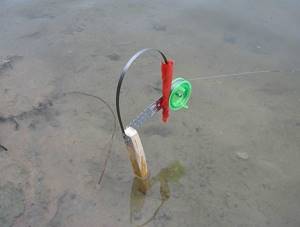
If in a colder period fishermen have the opportunity to try to catch this fish anywhere in the river, this can be done by the ice that binds the water, but in the summer the task becomes more complicated - the place for catching is promising, but difficult to access for most gear.
A peculiarity of the pike's habits is its love for shady places, a pond covered with thickets, reeds, the presence of snags, and logs.
These circumstances make it difficult to catch a predator using a spoon, but there is another way that allows you to catch pike of any size from the most inaccessible places.
Fishermen call this principle of fishing differently: set-up or girder, but this does not change the essence of the gear.
Summer rig for pike
To set up the gear you will need:
- leash - the optimal length when catching individuals up to 5-7 kg is at least 35 cm, for larger fish you will need over 70 cm. This increases the number of bites. You should not make it longer than 1.5 - 2 m, since the likelihood that the fish will go into the thickets increases. It is also not advisable to take a soft or thin leash without a plastic coating, as the pike can chew the line or break it.
- fishing line or nylon thread - the length is selected specifically for the selected reservoir and most often up to 20 m, and the diameter does not exceed 0.5 mm.
- sliding load - for floating girders, the optimal weight of the load should not exceed 5-10 g. It is calculated for each tackle depending on its diameter, size and weight of the live bait individually.
- swivel - is a mandatory component of the rig, used to prevent tangling of the fishing line and stops the sliding load. This element contains a roller mechanism that ensures free sliding of the line when fishing for fish up to 20 kg.
- hook - doubles or tees are used. Their choice depends on the type of bait and the method of attaching it. A live bait is placed under the gill cover on a double, and under the back - on a tee.
About
Pole
Zherlitsa, bottom tackle. As a fishing rod (if you can call it that), choose a long, fairly strong pole that can be cut down on the shore. It should not be dry, otherwise it will crack or break. It is stuck deep into the ground, at an angle. The thickness of this pole will depend on the fish you want to catch. If you place a pole on a large fish, then this pole should be thicker so that it can withstand powerful bites and resistance from the fish. The pole can also be tied to hanging tree branches to further secure and strengthen this pole. Choose a long pole. If the length of the pole is short, then the fishing line may twist around the pole when biting, and the girder will not work.
Catching pike with poles in summer, correct installation of poles
To successfully catch pike in the summer using a zherlitsa, you must:
- Choose the right fishing line thickness, taking into account the expected weight of the individual, fishing conditions, and the passivity of the pike;
- The place should be shaded, near springs and springs, near the border of clear water and thickets of water lilies;
- Considering that pike feeding time occurs from dawn to 9 am and after the heat subsides in the evening, the girders are set out at night or very early in the morning;
- The shore fastening of the gear must be securely fixed;
- The strength of the current and its presence in principle, as well as the weight of the live bait, determine the size of the sliding load and the type of swivel;
- To keep fishing simple, it is not recommended to install more than two leashes.
summer pike fishing
Of course, various types of girders can be purchased at specialized fishing stores, but if this method is not suitable, then you can make a girder yourself.
The easiest and most inexpensive way is to make a slingshot from an ordinary stick. Its size should be up to 15-16 centimeters, the horns are ideally the same size. Splits are made on the bottom of the horns, within two centimeters in size, and in the upper part it is necessary to make a hole into which a rope can be threaded. Instead of a hole, you can make a groove into which the fishing line will be wound.
If you use a fishing line rather than a rope, it should not be too thin, and it should be wound into the groove in such a way as to prevent the possibility of it unwinding on its own. If the bark remains on the slingshot, this is even good, as it will allow you to disguise the tackle as an ordinary tree branch.
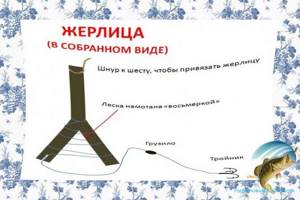
Some fishermen, for the purpose of camouflage, paint the horned fish in the color of the surrounding area; green or brown is optimal. The zherlitsa blank is ready. Next, you need to thread a long rope into the hole, its length is about 15 meters, the rope should not be thick, only 2-3 millimeters, but strong.
It is advisable to lubricate it with oil or special resin. After this, the rope or fishing line needs to be wound around the slingshot, crossing it on the legs in the form of a number eight. A hook is attached to the end and, after unwinding several meters, it is lowered into the water.
If fishing takes place in a shallow place, then a sinker will not be needed, but if the place is deep, then it is advisable to use a weight, and it must be possible to pass a fishing line or rope through it, and it must also be heavy enough in order to reduce swinging gear in the wind.
How to catch pike on girders in summer
The presence of a current requires a more careful calculation of the weight of the sliding load and the method of fastening the vents. This differs somewhat in the way the gear is installed. Put it right
On the river
Fishing for pike on the girder river involves the use of a fishing line with a diameter of up to 0.6 mm and a length of no more than 8 m. Considering the presence of many snags near the bays of the reservoir, it will not be possible to insert a short fishing line into the “fishy” places. The weight of the sliding weight is chosen to be slightly larger than 10 g in order to keep the line flowing and balance the movements of the live bait, bringing it closer to the natural feeding behavior of the pike. In addition, a weight lying motionless on the river bottom holds the leash with bait in the desired position.
About
Nuances of assembling different types of vents
It’s not difficult to make a summer vent yourself, so even a beginner can handle the assembly process. However, you should not neglect recommendations from experienced fishermen.
Materials for production can be any available means.
Since installation of gear is possible both from the shore and from a boat, there are 3 main types of girders. They have significant differences in design and assembly process:
- put it on,
- hanging,
- moored.
Let's look at each of them in more detail.
Postavushi
The most ancient zherlitsa. Fishermen still use a simple version of the device. There is a modified device with a coil or a floating one.
Simple
Manufacturing is carried out in the following sequence:
- Initially, we make a reel from any available material (plastic bottle, piece of board).
- We wind a thickened monofilament line with a diameter of 0.4–0.6 mm and a length of 20 m on it. That is, 100 m of fishing line is just enough for 5 girders.
- We tie a weight to the end of the fishing line.
- We knit a leash 40 cm higher along the line. We make it from this fishing line, woven in half or three times.
- We attach a tee or double to the leash.
- We put on live bait.
- We attach the other free end of the fishing line to a tree, stone, and, if necessary, drive a peg into the ground.
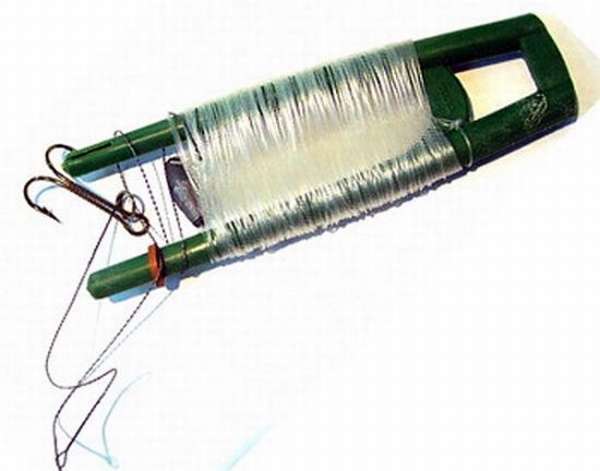
The photo shows a finished postavushka of simple design.
When installing a fishing line on a summer fishing line, it is important not just to secure it, but to make a loop 1–2 m long and secure it with an elastic band. This is necessary so that the pike, when swallowing live bait, does not feel the resistance of the gear, which leads to a decrease in escapes.
With reel
Such homemade devices work according to the following principle:
- A stand equipped with a reel and a flag is stuck on the shore.
- The loaded rig with live bait on the hook is thrown into the water.
- The flag is charging.
- At the moment of a bite, the reel rotates, thereby releasing the flag, which indicates a bite.
- At the same time, the pike, without feeling resistance, leaves with the live bait, and the fishing line is unwinded from the reel.
Such girders can be placed from a boat, combining passive fishing with active casting of a spinning rod.
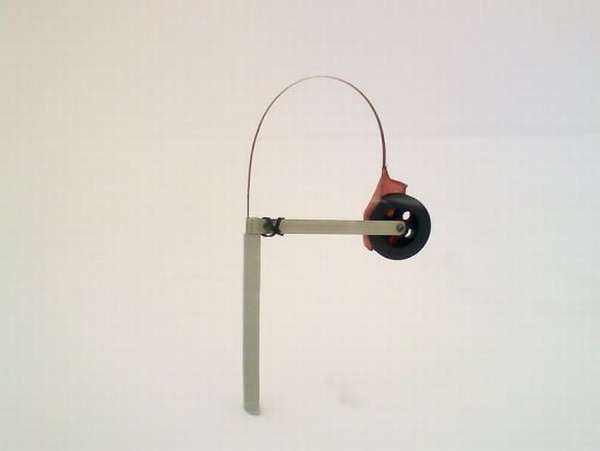
A set-up with a reel is rightfully considered an improved winter tackle.
floating
The two types described above are effective on rivers with strong or weak currents, when the baitfish goes under the water at an angle and its behavior looks natural.

A floating fishing rod is the best option for fishing in still waters.
If such a design is used on a pond, the hook will simply fall to the bottom or hide in the thickets.
In these cases, it is worth using a floating vent.
You can do it yourself this way:
- The float is made from a piece of polystyrene foam, a plastic bottle, or a board. An alternative is to build a small raft of reeds by tying the stems in several places. This way the pike won’t suspect anything.
- We mount a working line with a weight and a hook with live bait to the float.
- We also knit a transport line to it.
- The worker is lowered into the water.
- The float is pushed away from the shoreline.
- The transport is fixed on pegs on the shore.
Fishermen also call the floating set-up a circle. Often they stock up to 5 pieces and cast from a boat or shore, making close casts with a spinning rod.
Hanging
No less ancient and popular type of zherlitsa than postavushi. Made from improvised materials. They come in a classic form or with the use of shock absorbers.
Classical
In the case of a wooden base, we assemble in the following order:
- In the upper part of the slingshot we drill a hole for a lanyard for hanging.
- A line is wound in a figure eight from the narrow part of the slingshot.
- At the bottom of the slingshot, cuts are made to secure the fishing line.
- The fishing line is equipped with a sliding weight, a leash with a hook and live bait.
- The tackle is suspended from a tree at a height that allows the bait to be lowered to the required depth.
- When a bite occurs, the line jumps out of the clamp and the slingshot unwinds.
In addition, a regular elastic band for money will be a convenient way to secure the fishing line.

The basis of such a girder can be a wooden flyer in the shape of an inverted letter “Y”. An alternative is a piece of a plastic bottle, polystyrene foam, or part of a polyethylene tube.
With shock absorber
Among the main elements are a fishing line with equipment, an elastic band and a pole.
We get a working vent when assembled in this order:
- To the edge of a pole or a long wooden stick we tie a fishing line with equipment (similar to other types).
- At the same end we also install an elastic band ¼ of the length of the fishing line.
- The fishing line and elastic band are re-tied near the leash.
- Then the fishing line is fixed at the end of the pole so that its length is equal to the elastic band. The zherlitsa is ready.
A properly assembled girder with a shock absorber is a guarantee of self-hooking of pike and a good catch.
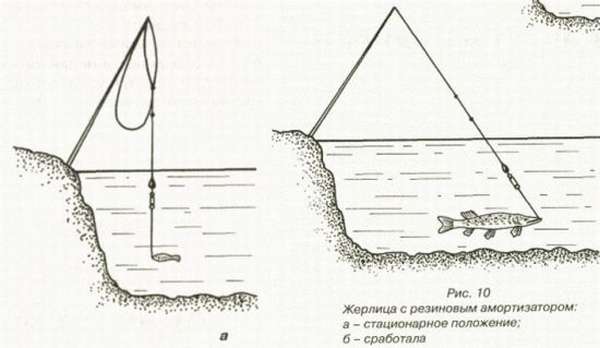
Such a girder will only work if the length of the shock absorber - rubber band - is correctly selected.
Moored
Installation and installation are as follows:
- We anchor the boat in the right place in the reservoir.
- We choose a suitable load that will become an anchor for the girder. We tie a cord to it and lower it to the bottom.
- We attach a plastic bottle to the upper end of the cord, which will serve as a float.
- Now we knit a meter stick to the bottle at one end.
- We mount the working line with all the equipment to the other edge of the stick.
- The equipment is the same as that of other species with the exception of the leash. An additional weight should be attached to it in the center. This is necessary so that the live bait does not tangle the tackle.
An anchored girder is also convenient because the live bait does not have the opportunity to overlap the fishing lines.
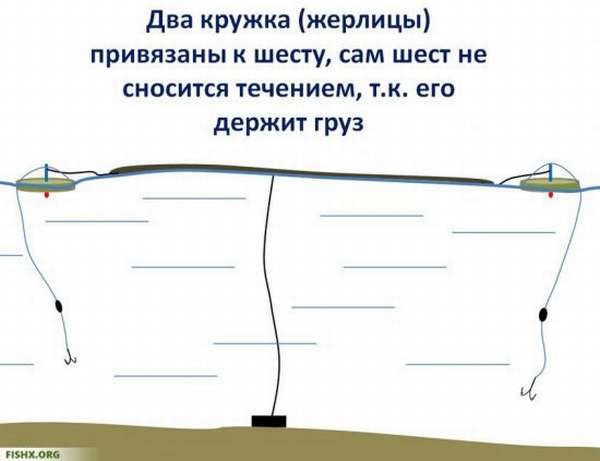
It is recommended to install this girder in areas of the reservoir that are located away from the shore.
How to make summer girders for pike with your own hands
To make a trap for predatory fish, you need to choose the type of gear depending on the type of reservoir where you plan to fish. The most common in summer are mugs, homemade slingshots, as well as converted winter girders. Let's take a closer look at how to properly make one or another summer girder for pike with your own hands.
From the winter zherlits
You can prolong the pleasure of pike fishing in the summer using a winter girder with the help of a small modification. More details in the video below:
Mugs
To make this tackle you will need polystyrene foam, a spool of fishing line and a stand for it, a plastic stick-pin, and red paint. A circle with a diameter of up to 20 cm is cut out of foam plastic up to 2.5 cm thick. A stand for the reel and a signal flag are installed in the center so as not to interfere with the movement of the fishing line. A hole is made in the circle for laying fishing line with a hook attached at the end. With the help of a 2-3 meter long rope and a load, the circle will not be carried away by the current or wind.
Only the top side of the tackle should be painted red. This way the bite will be noticeable, since the circle will turn over, and the whiteness of the bottom will be more noticeable from afar.
Slingshots
Do-it-yourself summer flyer made of plywood
This device is made from branches of a bush, willow, hazel or young willow with a slight divergence angle. If such material is not found, you can take a twig with a slightly larger fork angle and tie it with twine during the drying process.
About
Conditions for successful fishing
Just collecting the gear is not enough, you need to know where to put the girder, and another important factor is the bait. Only by combining all the factors will it be possible to accurately spot and catch a trophy specimen of the toothy predator. Let's look at what you should pay special attention to below.
Selecting a location
For fishing, homemade girders must be installed in promising areas of the reservoir, such as:
- along coastal vegetation;
- near snags and fallen trees;
- at the exit from pits and at pools;
- in the heat near aquatic vegetation.
On rivers, it is effective to place girders where the current makes a turn. Usually, holes form in this place, in which small fish stand, which the pike eats with pleasure.
Choice of live bait
Without high-quality bait, summer fishing for pike with your own hands will be useless. Active live bait is used as bait . It is advisable to get it from the same reservoir; a float rod will help with this.
The following is used as bait for summer bait:
- crucian carp;
- minnows;
- roach;
- ruffs;
- bleak.
The freshly caught fish is carefully placed on the hook and the gear is set, and then it’s a matter of little things. The pike will definitely pay attention to the fry splashing nearby and attack it in the near future.
Installation of vents
In summer, a pike rig can be used both from the shore and throughout the entire area of the reservoir. They are installed in different ways, it all depends on the type used:
- The spears are attached to bushes or a rigidly fixed peg near the shore. Then they unwind the required amount of fishing line and place the live bait with a sinker in the chosen place.
- The mugs are displayed from the watercraft, they are placed in promising fishing areas throughout the water area. The live bait is lowered to a depth of 1 m to 2 m and the fishing line is fixed. The circle itself should notify the fisherman about the bite; it should turn over with its white side.
Both types of jigs are used for pike both in still water and in rivers.
Checking gear
In summer, the zherlitsa is usually displayed in the evening or early morning. During the heat of the day, the predator hides in holes and comes out to eat at night or early in the morning. It is before this period that you need to have time to set up your gear.
They check the gear in the morning, when the sun rises sufficiently above the horizon. If the fish is hooked, you should not immediately jerk the tackle sharply, it is better to lower the line a little, but do it in such a way that the predator does not go into snags or grass . Next, you should make a sharp jerk and gradually tighten the fishing line, winding it on the reel.
The converted winter girder catches in the same way as the circle. Everything is carried out in the same sequence, and the equipment is absolutely identical.
Hanging
Classical
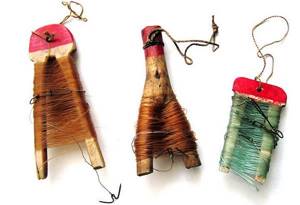
These zherlitsy have been used in the summer for as long as the postavushi. This kind of homemade tackle used to be made from a cut upside down flyer, imagine an upside down letter “Y”. It was done like this:
- At the upper end of the slingshot, a hole was drilled for a cord for hanging.
- Starting from the narrow end, a fishing line or nylon cord was wound around the flyer in a figure eight.
- At the bottom of the horns there was a slot for pinching the fishing line.
- A sliding sinker was put on the cord, and a leash with a tee was tied.
Equipped with live bait, the bait was suspended on a cord from a tree or a pole stuck into the shore above the water so that the bait was at the required depth. When biting, the line was released from the clamp, and the flyer began to unwind, throwing off the line.
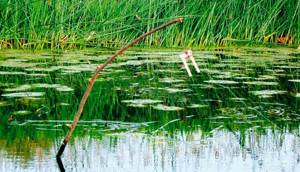
Nowadays, such a girder for pike fishing can be easily made from a small plastic bottle or a piece of polyethylene tube. Polystyrene foam with polystyrene is also used for this, and bank rubber bands for money are now increasingly used as a line fixer.
With shock absorber
There is a suspension option without using anything other than a rubber shock absorber. This design contains only a pole, an elastic band and a fishing line with equipment. The main thing in assembling such equipment is to correctly measure the length of the shock absorber. This design is assembled like this:
- A working fishing line with equipment is tied to the end of the pole: a sinker, a leash and a hook.
- A rubber shock absorber is also attached to the same end, the length of which is a quarter of the length of the fishing line.
- The line and elastic band are tied together again at the leash.
- The fishing line is pinched at the end of the pole so that its remaining part is equal in length to the elastic band.
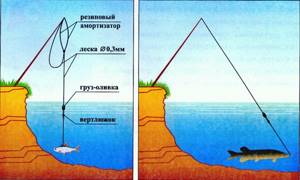
Now, when you bite, the line will be released, and the elastic band will absorb the jerks of the pike. When the predator pulls the elastic band to the length of the fishing line, a self-hook will occur.
